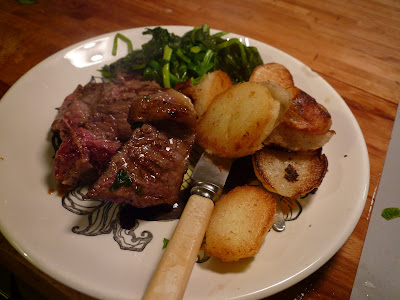peanuts on the boil
You need to eat with lots of other people to get the best of Szechuan food. All this food fed ten or eleven people.
Aromatic peanuts (lu hua sheng) are just raw peanuts boiled with fennel seeds, star anise, Szechuan pepper, cloves and cinnamon for forty minutes. A good thing to have on the table before the meal starts. There's a moments confusion when you bite into them and find they're starchy and glutinous and not crunchy but they are very nice and dead easy to do. You can taste the anise quite clearly.
Spring rolls were crafted by my expert co-cook from cabbage, carrot, spring onions, shiitake mushrooms, bean-sprouts and pickled bamboo shoots. Delicious, the mushrooms added a welcome chewiness and the bamboo crunch.
Steamed aubergine (hong you qie zi) is again, super easy. Slice the aubergine (I omit the salting stage often specified by cooks/books including FD and have never had any problems) and put in a steamer with any flavourings you like. We went for fermented black beans, pickled chopped chilli and dried chilli flakes (just Turkish ones) but you could of course go for ginger, garlic, chopped spring onions, pickled vegetables or anything you fancy.
before
The wonder of the steamed aubergine is its texture: nearly as satisfying as a vigorously fried version, but thirstily drunk on water vapour rather than oil. An unexpectedly sweet smell emanated from this. They exuded lots of liquid which took on a sugary, malty taste that combined well with the spice of the chillies.
after
Cucumber salad (qiang huang gua) was just cucumber with the middle scooped out dressed with toasted dried chilli, Szechuan pepper and sesame oil. I forgot to smack these!
Mopo tofu - we had Hunan style with shiitake but sans meat to accommodate vegetarian brethren/sistren.
these are about 70p from Chinese supermarket - get involved!
The recipe in FD's Revolutionary Chinese Cookbook: Recipes from Hunan Province specifies no less that four different preparations of chilli - chilli-bean paste, dried chilli, fresh chilli and salted chilli. Amazing. Check a full recipe for mapo tofu.
all the flavourings ready for adding to the tofu
the finished article
Twice-cooked pork (hui guo rou) is normally done with pork belly I think. I had some fatty chops described as Chinese chops or something similar (they were streaked with fat and not your classic bacon shape one) and used those. You gently poach the pork until it's just cooked, then cool. It's then sliced thinly and fried till the fat runs. Chilli bean paste, black beans, sweet wheaten paste (I used Hoisin which a guy in a Vietnamese supermarket in Dalston suggested) are added and then spring onions chucked in at the end. I also went for some red pepper too, which gives the dish a bit of colour. They'll need a few extra minutes to start to soften.
Veg-wise we had cabbage, kale and bean-sprouts stir-fried with garlic and dressed with toasted sesame oil and Chinkiang vinegar.
in a pretty pink bowl




































